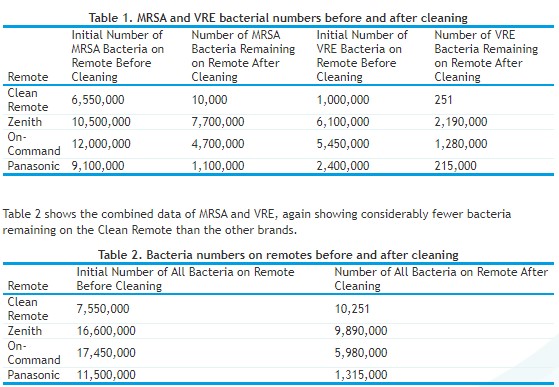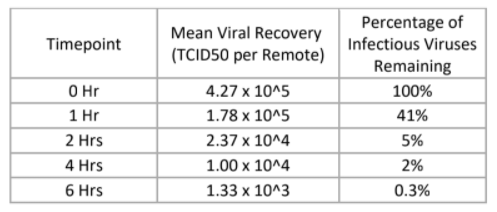Cleaning of Bacteria Contamination on TV Remote Controls
Sheri Maxwell, B.S.
Charles P. Gerba, Ph.D.
Department of Soil, Water and Environmental Science
University of Arizona
Tucson, Arizona. 85721
June 15, 2007

Introduction
According to a previous study, the television remote control was found to have the highest level of bacteria in a patient's hospital room, which can lead to nosocomial infection, or hospital-acquired infection. More than 2 million Americans acquire hospital-related infections each year with almost 90,000 deaths reported. Each year, patients with hopistal-acquired infections increase hospital bills by more than $9.5 Billion.
Objective
The purpose of this study was to determine if a TV remote with a flat surface was more conducive in removing bacterial contamination.
Materials and Methods
Four different brands of TV remotes were used in this study: Panasonic, On-Command, Zenith and Clean Remote. An overnight culture of Methicillin-Resistant Staphylococcus aureus (MRSA) and Vancomycin-Resistant Enterococcus (VRE) was used to inoculate the remotes. A sterile cotton tipped applicator was dipped into the bacterial suspension and applied to the face of the remotes. After inoculation, the remotes were allowed to air dry for 30 minutes. Each brand of remote was swabbed to determine the number of bacteria that remained after air drying. The remaining remotes consisting of two of each brand were cleaned with Clorox Disinfecting Wipes using a sweeping motion three times on the face of the remotes. The surface of the remotes was then sampled with a swab that had been pre-moistened in a neutralizing broth. All remotes were cleaned and swabbed in the exact same manner. The swab was then placed in 1 mL of neutralizing broth. Dilutions of the sample were assayed onto Tryptic Soy agar amended with 5% sheep blood for analysis of MRSA and VRE. The petri dishes were incubated at 35 degrees C for 48 hours and bacterial colonies counted. All remotes were disinfected between experiments by spraying twice with 70% ethanol and exposed to UV light for 12 hours.
Results and Discussion
Results in Table 1 show the initial numbers of MRSA and VRE on the TV remotes before cleaning and after cleaning. The Clean Remote had considerably fewer bacteria on its surface face than the other brands. The Clean Remote had far fewer initial bacteria. The reason for this is unclear. It could be that the greater surface area of the regular remotes with raised buttons results in capture of more bacteria i.e. the swab touches more surfaces during inoculation of the remote. This implies that during use the flat remotes get less contaminated than the ones with buttons, because more surface is handled when they are used. This could be another benefit of the flat remotes.

Human Coronavirus Survival On Clean Remotes
Department of Soil, Water and Environmental Science
University of Arizona
Tucson, Arizona. 85721
September 28, 2020

Results and Discussion
Table 2. Human Coronavirus 229E Survival On Clean Remotes

Viral levels were reduced by > 99% over the 6-hour period.
Disinfectant Sanitizer Cleaner using Microfiber Cloths

